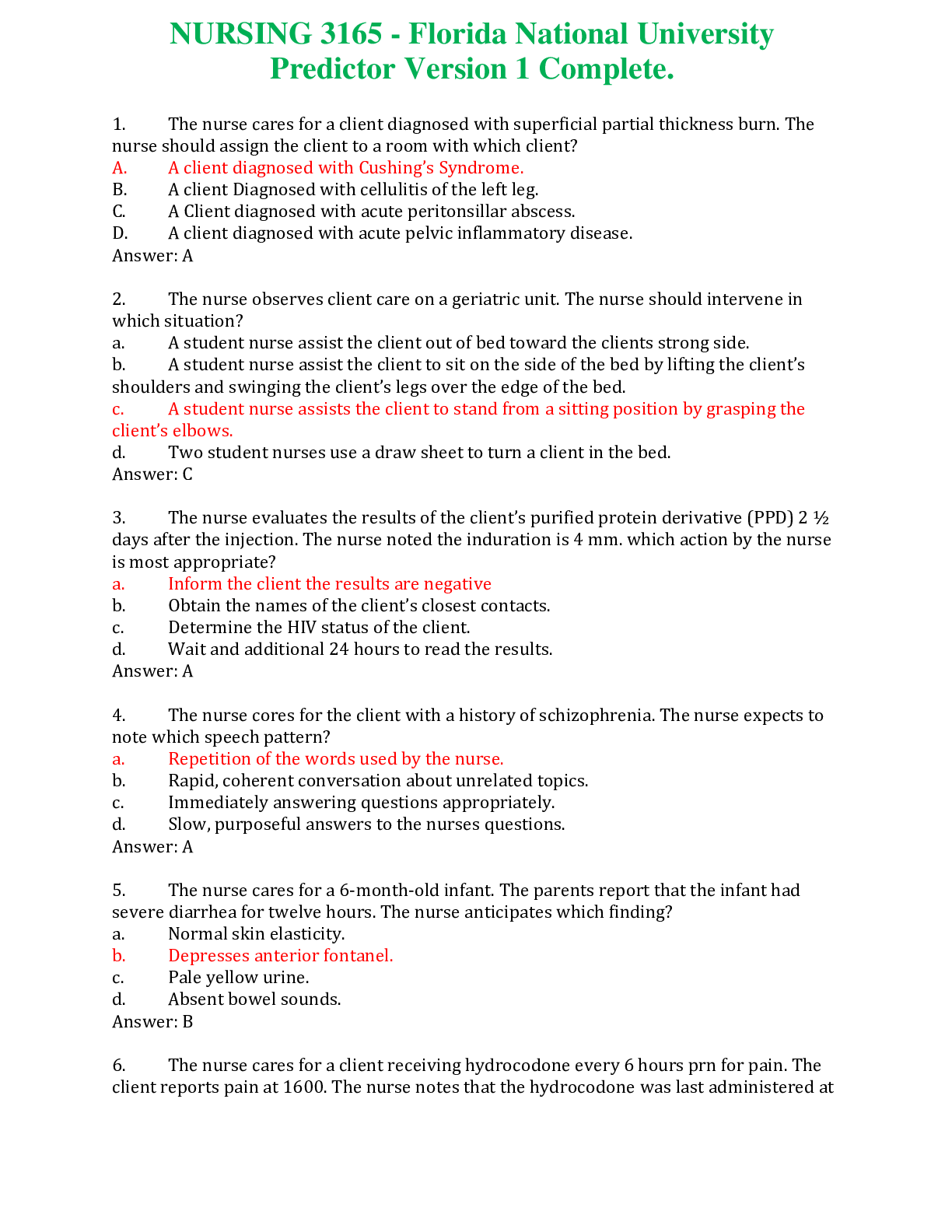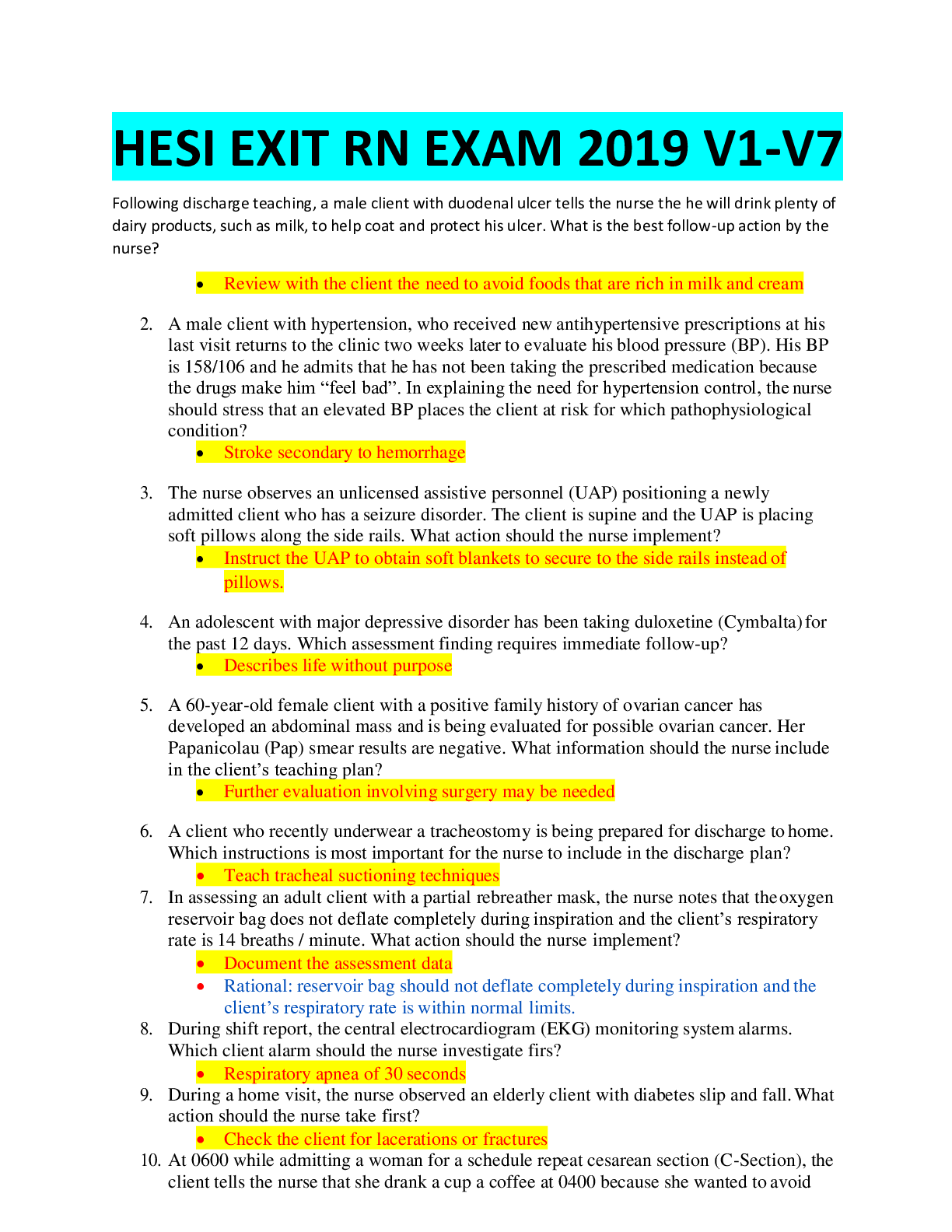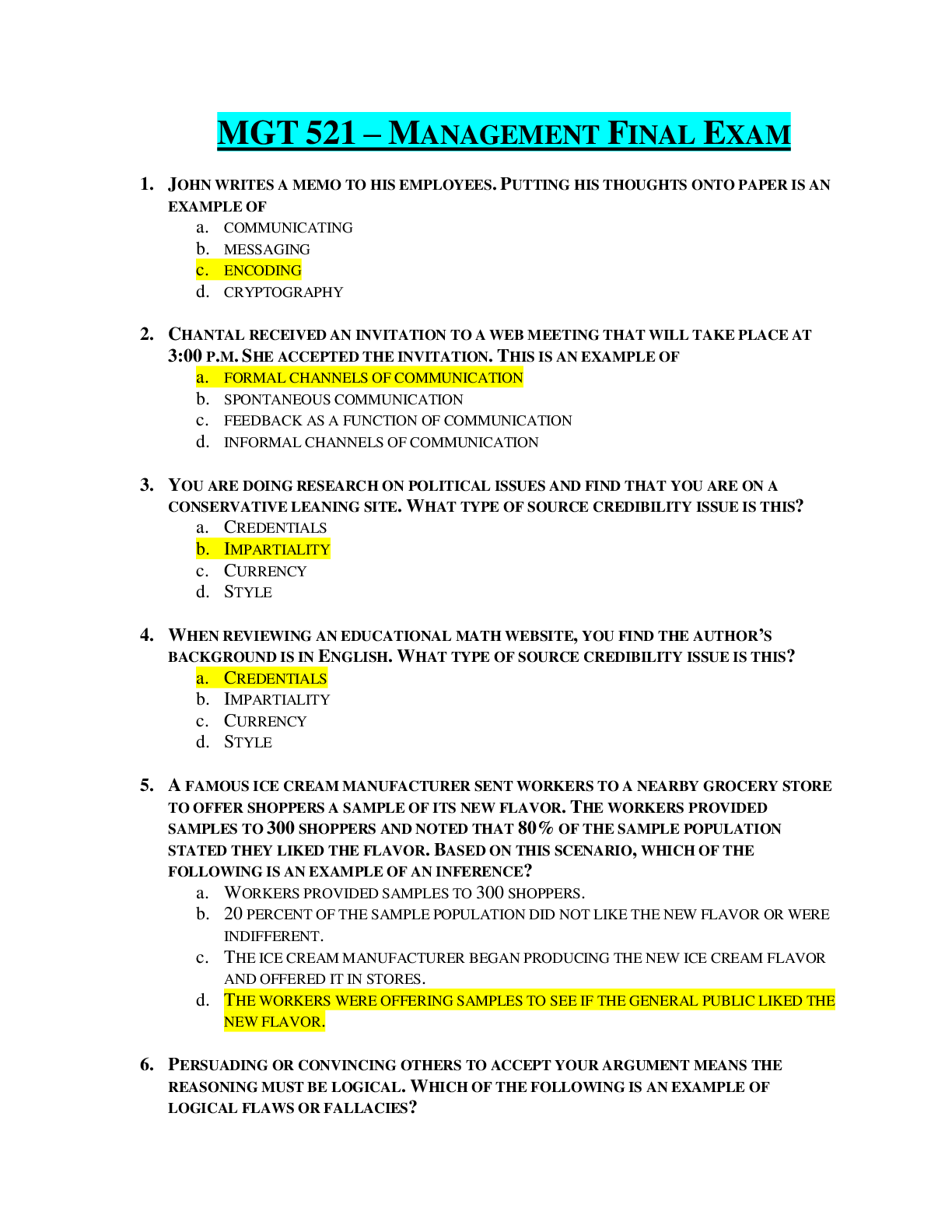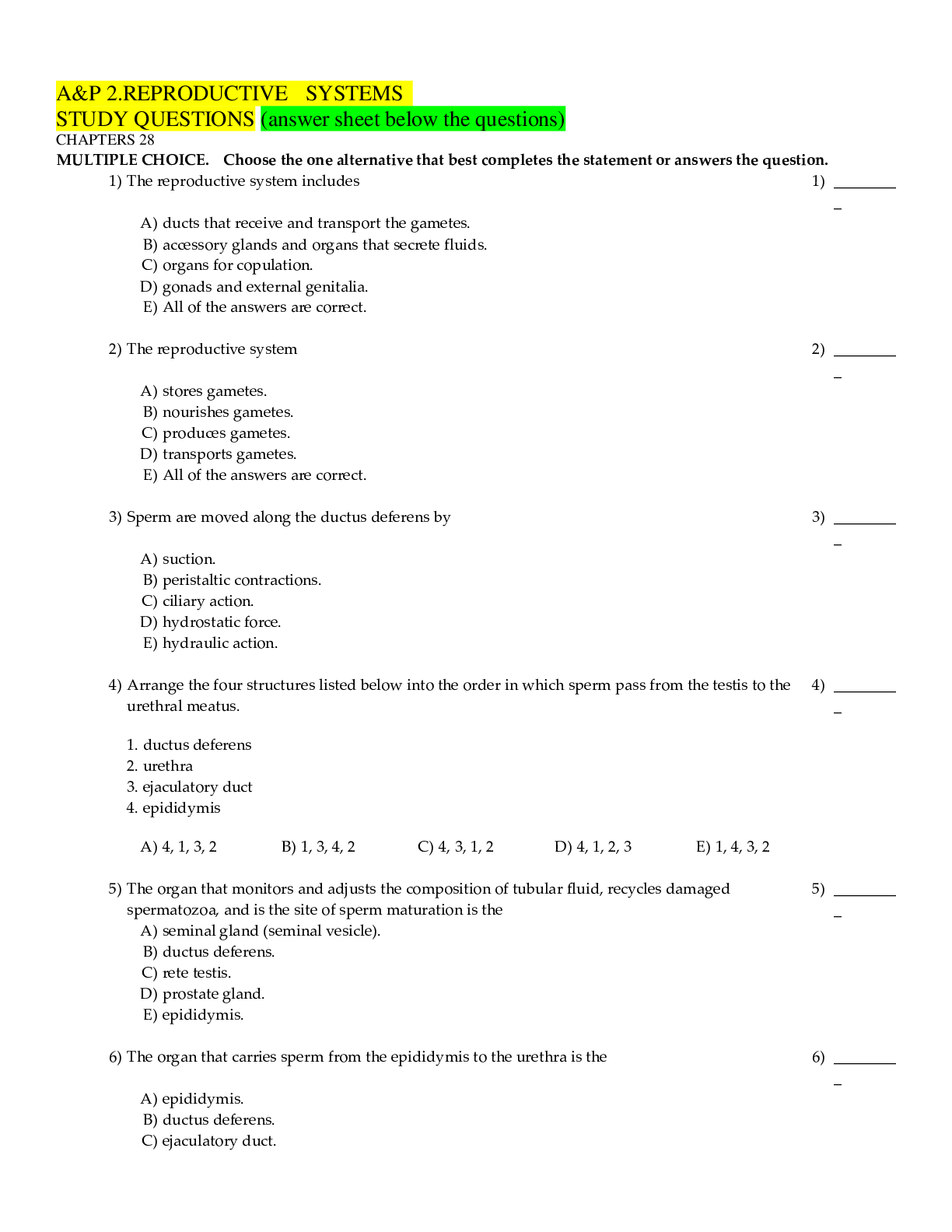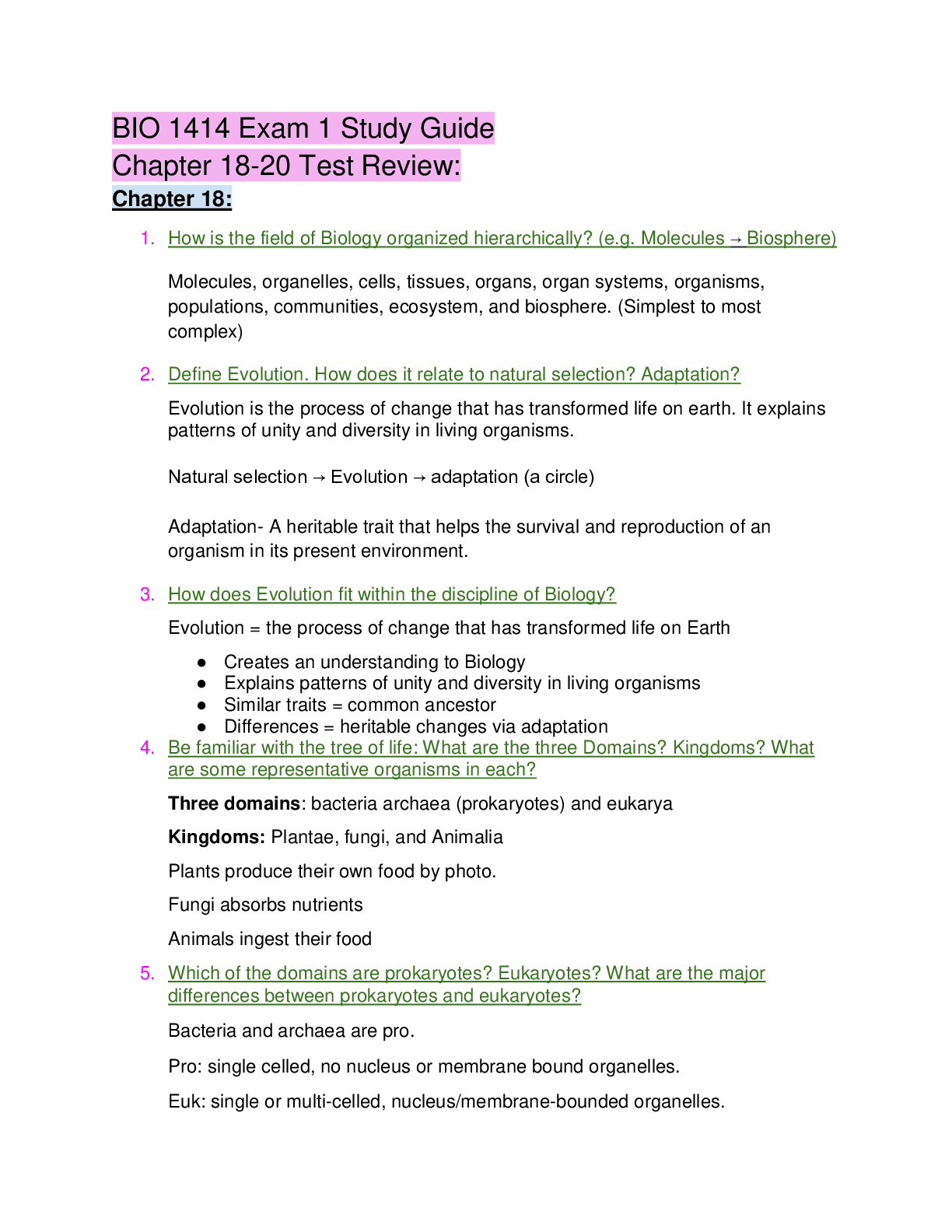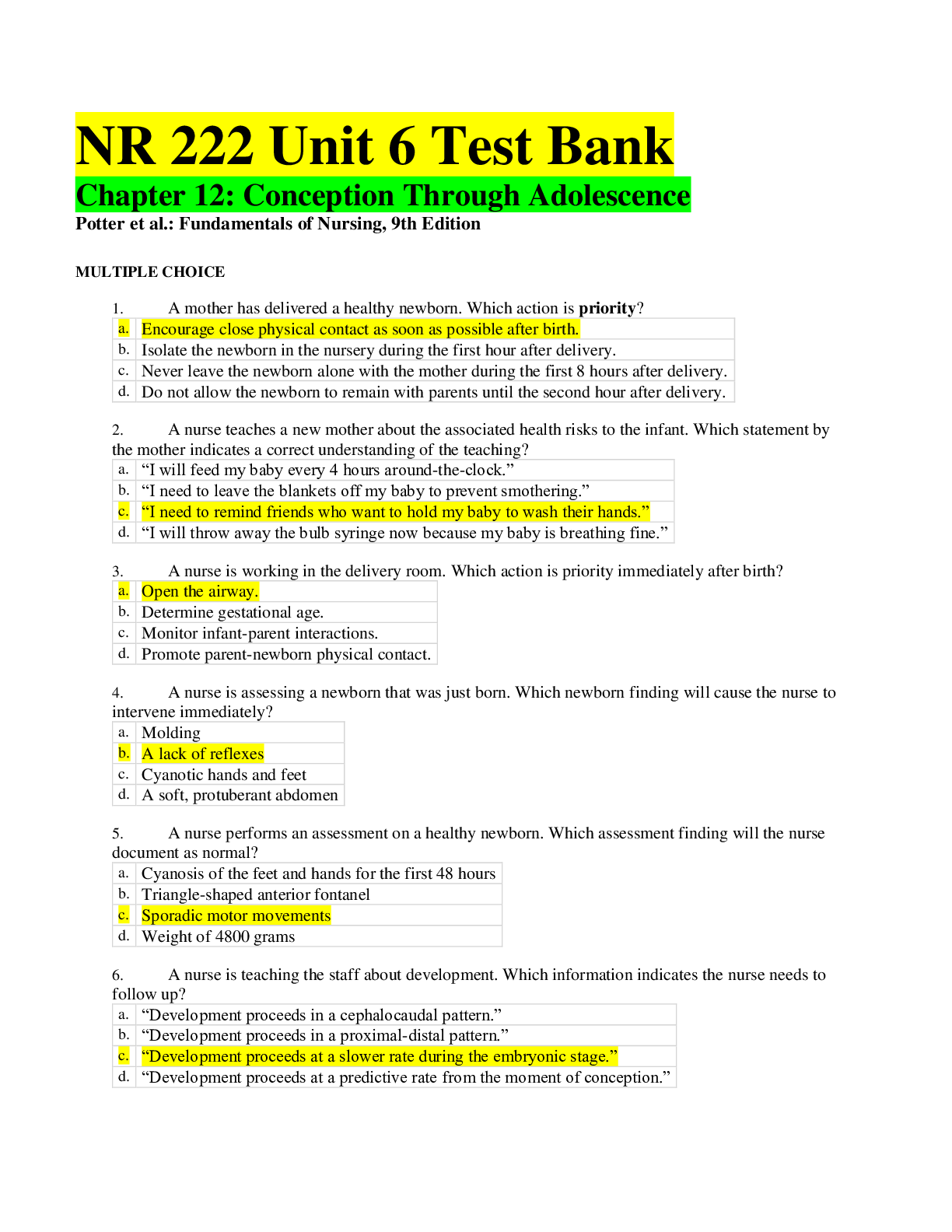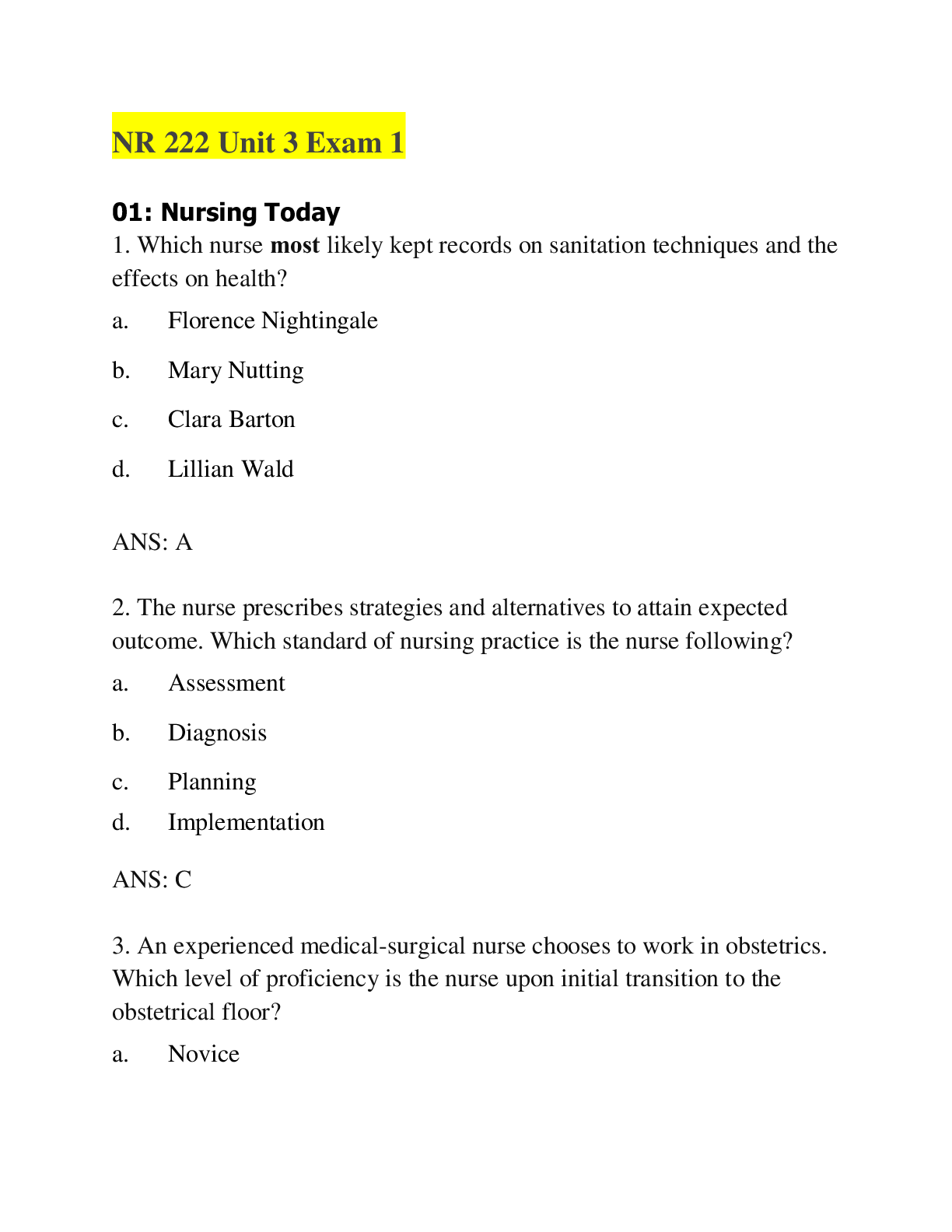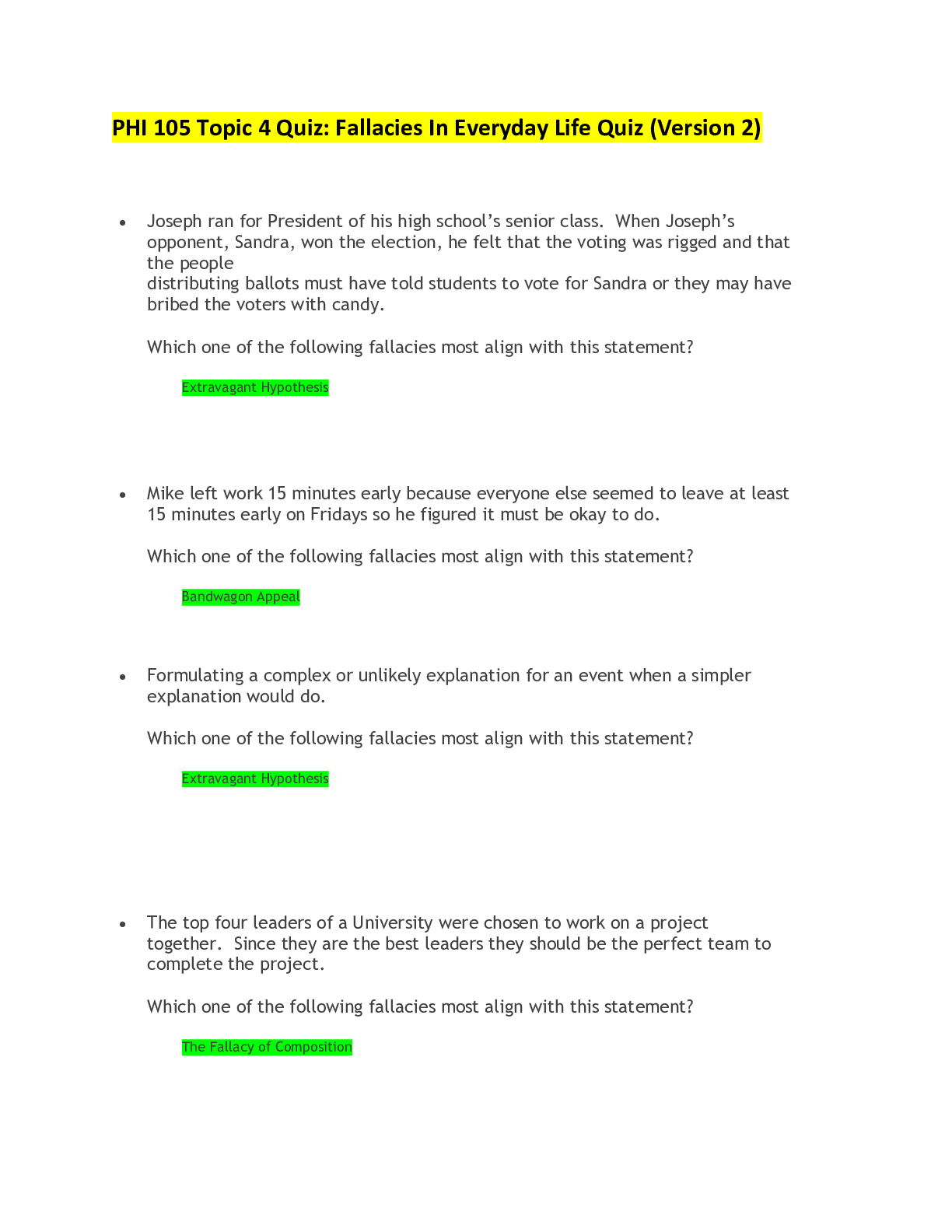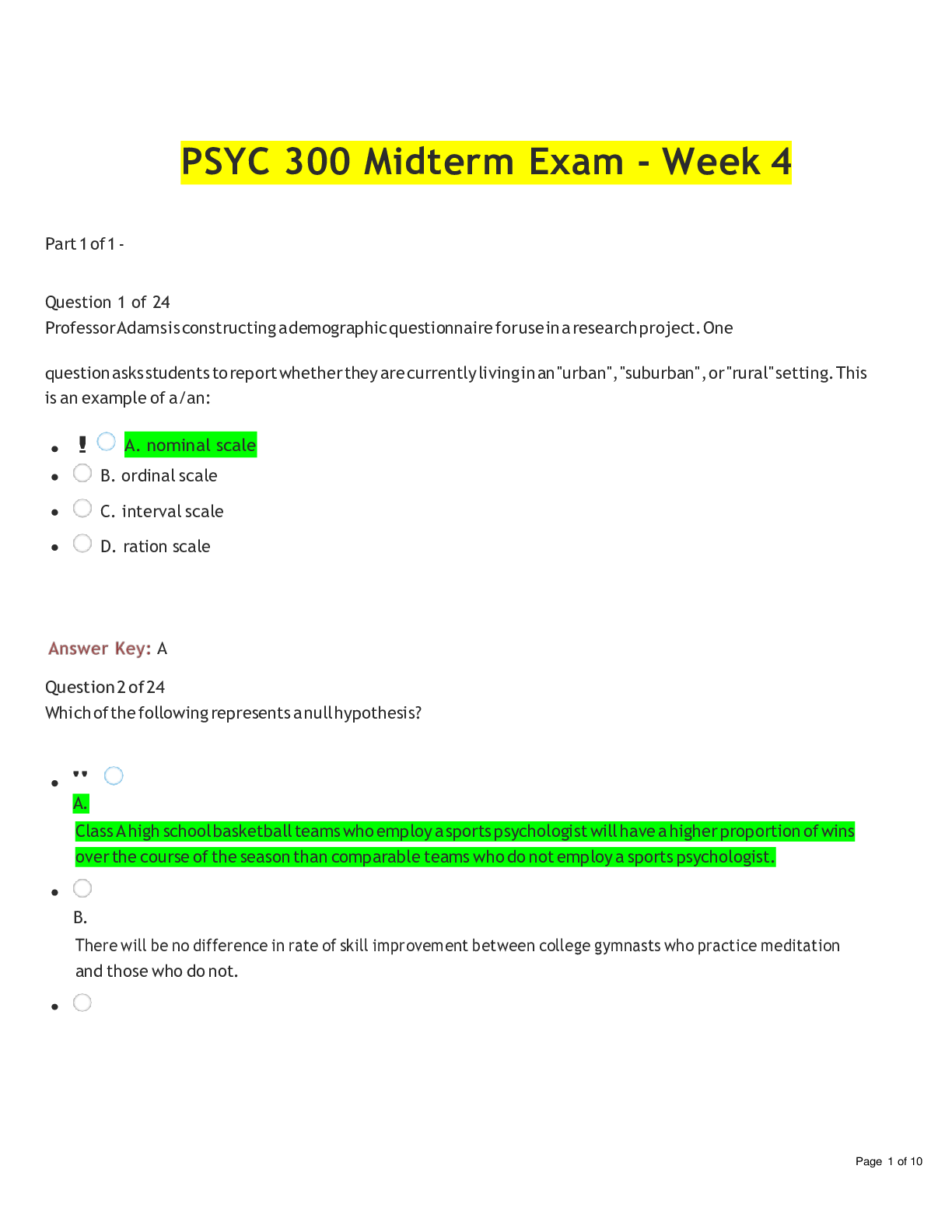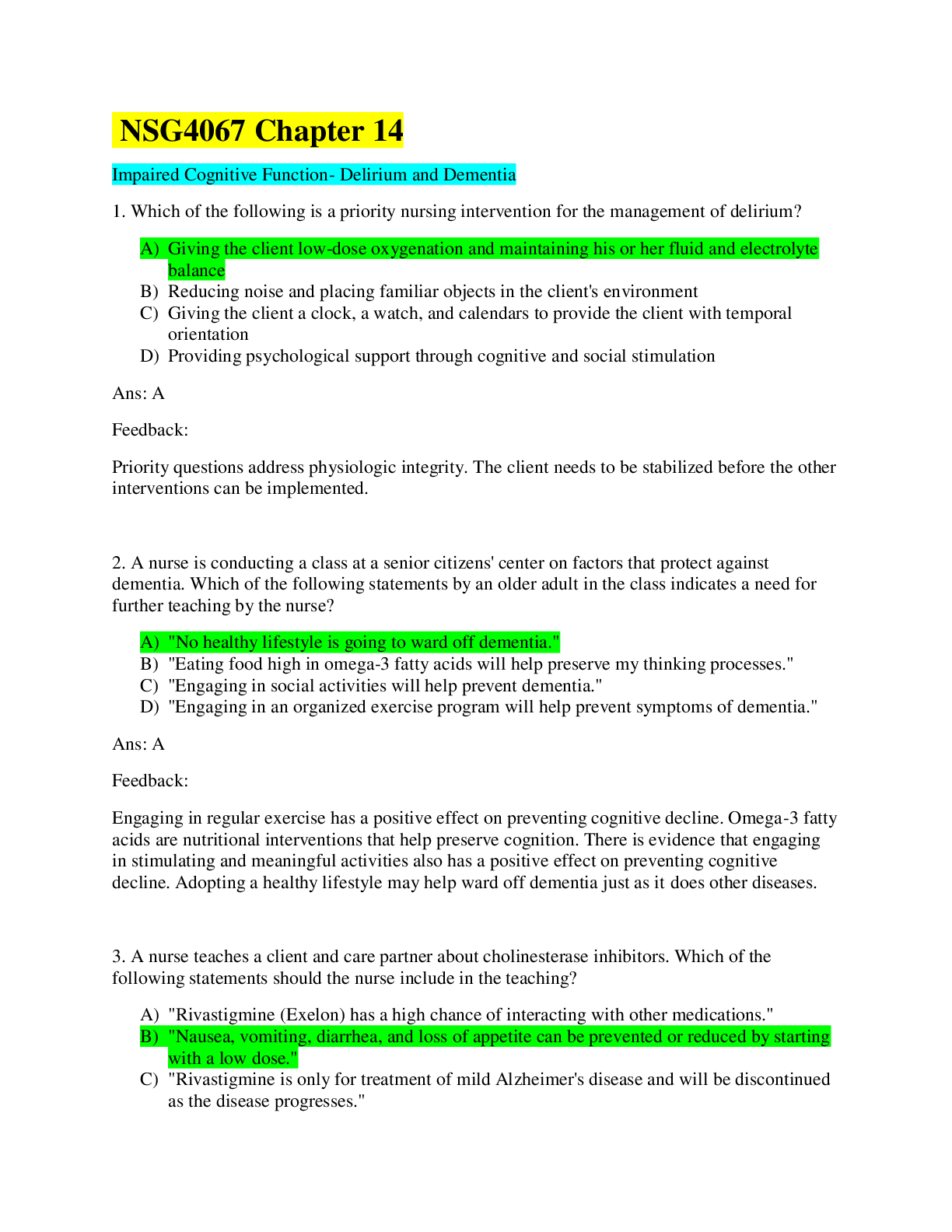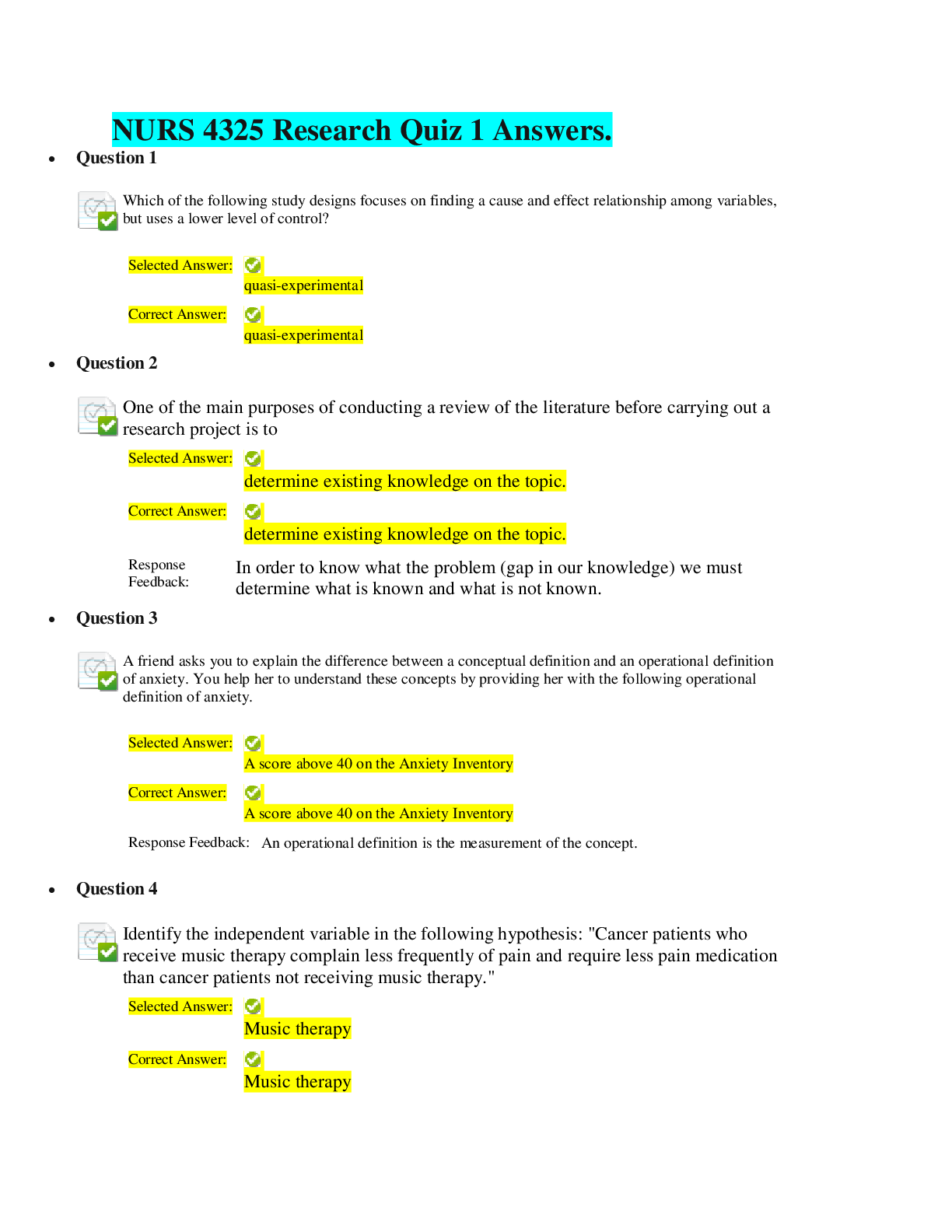*NURSING > QUESTIONS & ANSWERS > NUR 4827 Toddlers Test Bank Questions & Answers (important) Latest 2022/2023. (All)
NUR 4827 Toddlers Test Bank Questions & Answers (important) Latest 2022/2023.
Document Content and Description Below
NUR 4827 Toddlers Test Bank Questions & Answers A nurse bases the plan of care for a 15-month-old toddler with celiac disease on the pathophysiology of the disorder, which is characterized by an: ... A parent tells a nurse at the clinic, "Each morning I offer my 24-month-old juice, and all I hear is 'No.' What should I do? I know she needs fluid!" What is the best response by the nurse? Antibiotic prophylaxis is prescribed for a 2-year-old child with a cardiac malformation who is awaiting corrective surgery. The nurse explains to the child's parents that the antibiotic will prevent: A nurse is teaching dietary management to the parents of a toddler who is undergoing chelation therapy to treat lead poisoning. What should be included in the discussion of the dietary plan? A toddler who was physically abused is admitted to the pediatric unit. What behavior does the nurse expect when approaching the child? A nurse is observing two 18-month-old children playing side by side in a sandbox. Although they watch each other, neither interacts with the other. What type of play does the nurse identify? A nurse is caring for a toddler who has undergone bone marrow transplantation. What clinical finding(s) should the nurse anticipate if an infection develops? An 18-month-old toddler requires an intramuscular injection. As the nurse enters the room with the medication, the child begins to scream and flail about on the bed. The father is sitting at the child's bedside and gets up to leave. What action should the nurse take to best handle this situation? How should a nurse respond to parents who are concerned about separation anxiety in their 15-month-old toddler? A 3-year-old child ingests a substance that may be a poison. The parent calls a neighbor who is a nurse and asks what to do. What is the best response by the nurse? What does a nurse identify as the priority short-term goal for a toddler with dehydration caused by diarrhea? A mother tells her neighbor, a nurse, that her toddler has been found to have parasites (worms) and that the whole family will need to be treated. She asks the nurse what kind of worm it is. What is the most likely type of worm infestation? The mother of a 2-year-old child tells the nurse that she is concerned about her child's vision. What behavior when the child is tired leads the nurse to suspect strabismus? A nurse explains to the parents of a toddler why 2-year-old children are at risk for lead poisoning. What major risk factor does the nurse includes in the discussion? A nurse is assessing a toddler with plumbism (lead poisoning). Which organ system is of most concern because of the condition's irreversible effects? A 2-year-old child with previously diagnosed hemophilia is admitted to the pediatric unit for observation after a motor vehicle collision. The toddler has several bruises but no other apparent injuries. What is the nurse's specific concern regarding this child? The mother of a 2-year-old toddler tells the nurse that her child is frequently constipated. The nurse asks the mother how she handles the child's toileting. Which response indicates to the nurse that the mother requires further education? A toddler with hemophilia A is receiving factor VIII. The mother asks the nurse, "If my son hurts himself, I'll give him 2 children's Advil. Is that right?" How should the nurse respond? What is the priority nursing care in the immediate postoperative period for a toddler with a newly applied hip spica cast? A 30-month-old boy who was transferred to a regional hospital has not seen his parents for 2 weeks. He now responds to the staff with friendliness and affection. When his mother visits he turns away from her and ignores her. What should the nurse explain to the mother? A nurse is obtaining a health history from the mother of a 15-month-old toddler with celiac disease. The nurse expects the mother to indicate that her toddler: An unconscious toddler requires intermittent nasogastric feedings. When should the nurse check placement of the tube? The nurse notes that a 3-year-old child in a crib has a clamped jaw and is having a tonic-clonic seizure. What is the priority nursing responsibility at this time? The mother of a 2-year-old child calls her neighbor, who is a nurse, exclaiming that her child just ate some automatic dishwasher powder. What should the nurse tell the mother to do first? After a prolonged period in a regional hospital far from home to which the parents were unable to travel, an 18-month-old toddler becomes depressed, withdrawn, and apathetic. Eventually the toddler begins playing with toys and relating to others, even strangers. When the parents visit, the child ignores them. The parents tell the nurse that their child has forgotten them. The nurse explains that their child's behavior: Signifies typical behavior in toddlers who are separated from their parents for prolonged periods and that their child will need special attention from them The parents of a toddler tell the nurse the family has been living in a very old building. The nurse should carefully assess the child for the irreversible effects of possible lead poisoning by focusing on the: During a well-child visit the parents tell a nurse, "Our 3-year-old doesn't listen to us when we speak—he ignores us!" An auditory screening reveals that the child has a mild hearing loss. What should the nurse explain to the parents about this degree of hearing loss? What is the priority nursing responsibility in the care of a young toddler after a circumcision? Watching for bleeding around the penis A 13-month-old child is undergoing lumbar puncture for confirmation of a diagnosis of bacterial meningitis. During the procedure the nurse notes that the spinal fluid is cloudy. What does this finding indicate? A child sitting on a chair in a playroom starts to have a tonic-clonic seizure with a clenched jaw. What is the best initial action by the nurse? The parents of a 2½-year-old child whose older sibling recently died tell a nurse in the pediatric well-child clinic that their child has started to hit them and refuses to go to bed at night. What is the best explanation the nurse can give for this behavior? A nurse is reviewing how 18-month-old children with no hearing impairment usually communicate. What form of interaction does the nurse expect? During a nap, a 3-year-old hospitalized child wets the bed. What is the best response by the nurse? A 2-year-old toddler has hearing loss caused by recurrent otitis media. What treatment does the nurse anticipate that the practitioner will recommend? A nurse is conducting an assessment of a 1-year-old in the well-baby clinic. What activity does the nurse expect the infant to have accomplished? An 18-month-old child has received all required immunizations. What immunization should the nurse explain to a parent will be one of the vaccines required between 4 and 6 years of age? What foods should a nurse order for a 30-month-old toddler on a regular diet? A nurse teaches the mother of a 2-year-old child who has celiac disease which foods to avoid. Which foods identified by the mother indicate that she understands the teaching? A child with β-thalassemia (Cooley anemia) is admitted to the ambulatory care unit for a transfusion. What instruction should the nurse include in the plan of care? What is an important nursing intervention in the care of a hospitalized toddler with cystic fibrosis? A 3-year-old child with chronic lead poisoning who has not responded to succimer (Chemet) therapy must be given multiple injections of edetate calcium disodium (calcium EDTA). How should the nurse prepare the child psychologically for this treatment? The parents of a toddler with newly diagnosed cystic fibrosis ask a nurse what causes the problems related to this disorder. What should the nurse consider about the primary pathologic process before responding? The parent of a 2-year-old child tells a nurse at the clinic, "Whenever I go to the store, my child has a screaming tantrum because he wants a toy or candy on the shelves. How can I deal with this situation?" What is the best response by the nurse? A nurse is caring for a 3-year-old child with acute laryngotracheobronchitis. The child has severe dyspnea and a temperature of 104.0º F (40.0° C) and is receiving cool mist by way of a facemask. The mother asks why her child is not receiving warm mist. The nurse explains that cool mist: A 2½-year-old toddler is admitted with a fever of 103º F (39.4° C), stiffness of the neck, and general malaise. The diagnosis is acute bacterial meningitis. What is the priority nursing intervention for this child? When is the most appropriate time for the nurse to plan for chest percussion and postural drainage for a toddler with cystic fibrosis? A toddler has frequent temper tantrums. The parents ask a nurse how to limit this acting-out behavior. What should the nurse recommend? A toddler in the pediatric intensive care unit is on a ventilator. One of the nurses asks what should be done when condensation collects in the ventilator tubing. How should the nurse manager respond? The parent of a 14-month-old toddler asks the nurse how to proceed with bowel training. What is the best response by the nurse? A 19-month-old boy who has been in the hospital for 2 weeks becomes increasingly withdrawn and mute. What is the most appropriate nursing action? A 20-month-old girl is seen for her well-child checkup. The nurse assesses the child, taking vital signs and measuring height and weight. The nurse then plots the child's growth on the growth chart that the clinic has maintained since the child's birth. What information should be shared with the health care practitioner regarding the findings on the growth chart? A nurse is teaching parents of toddlers about why most children should be immunized against varicella (chickenpox) and why some receiving specific medications should not. Which medication should be included in the discussion? A nurse is assessing a 3-year-old child with a tentative diagnosis of lead poisoning. What clinical finding supports this diagnosis? A nurse discusses dietary instructions with the parents of a toddler with acute glomerulonephritis. What nutrients does the nurse list that are restricted? Select all that apply. A nurse is evaluating a 3-year-old child's developmental progress. The inability to perform which task indicates to the nurse that there is a developmental delay? A 3-year-old child has a tentative diagnosis of pinworm infestation. What should the nurse teach the parents about obtaining a specimen to confirm the diagnosis? The nurse explains to the parent of a 2-year-old child that the toddler's negativism is expected at this age. What need is this behavior meeting? Pinworm infestation is suspected in a 3-year-old child. The nurse teaches the mother how to collect a cellophane specimen from her child. What is the best time of day for the mother to collect the specimen? After the nurse has completed an oral examination of a healthy 2-year-old child, the parent asks when the child should first be taken to the dentist. What is the best response by the nurse? A pregnant mother asks about the best time to begin weaning her 2-year-old son from the bottle. What is the best reply by the nurse? A 3-year-old boy was recently found to have X-linked Duchenne muscular dystrophy. Neither parent has muscular dystrophy. Which statement indicates to the nurse that the parents understand the disorder's transmission? A 2-year-old boy with hemophilia A is to start receiving prophylactic intravenous infusions of the recombinant form of factor VIII three times a week. At what time should the nurse instruct the parents to administer the factor on the designated days? A nurse is teaching a group of parents about the developmental needs of young toddlers. What is the priority topic that the nurse should include? The mother of a toddler complains that the toddler has not been acting quite right lately. She has had a fever for a couple of days and now presents with decreasing oral intake and a rash over her hands and feet. Which condition does the nurse suspect? A 2-year-old child who is hospitalized for repair of tetralogy of Fallot is seen squatting in the playroom. In response to this behavior, what should the nurse do? A nurse in the pediatric clinic receives a call from a mother who states that her 2½-year-old daughter, whom she discovered in a kitchen cabinet, is crying that her mouth hurts. She is drooling, and her tongue and gums are white. The nurse gives the mother the number of the Poison Control Center, telling her to call immediately because the nurse suspects that the child has ingested: At 1 am a 28-month-old toddler is admitted to the pediatric unit with suspected meningitis. At 3 am, after the child is settled in, the mother tells the nurse, "I have to leave now, but whenever I try to go my child gets upset and then I start to cry." What is the best action by the nurse? A father asks the nurse about the immunization schedule for his 15-month-old toddler, who is being treated for acute lymphoid leukemia. What vaccine is contraindicated for a child undergoing chemotherapy? A male toddler is scheduled to receive methotrexate for treatment of leukemia. The mother asks the nurse whether the child should be started on vitamin supplements because he seems so weak. How should the nurse respond? A 2-year-old child is admitted with gastroenteritis and dehydration. Peripheral intravenous fluids are prescribed. What is the most appropriate site for the first intravenous insertion? The parents of a 2-year-old child who is being admitted to the hospital tell the nurse that their child is accustomed to sleeping with a favorite blanket. What should the nurse do, knowing that the blanket is worn and dirty? A nurse encourages parents to have their toddler's eyes tested especially for monocular strabismus. What should the nurse explain may occur if the condition is not corrected early? A nurse anticipates that an 18-month-old child who does not have hearing loss has acquired a vocabulary sufficient to enable him to communicate. What communication behavior should the nurse expect when assessing the 18-month-old toddler? A nurse is assessing the growth and development skills of several 2-year-olds in the clinic playroom. The nurse determines that the child requiring further evaluation is the one who: A parent tells the nurse, "Our 2½-year-old child only uses two-word phrases when he's talking, and we can only understood him maybe a quarter of the time. We're really concerned." What should the nurse consider before responding? A 15-month-old toddler has had no inoculations. The parent says, "I don't believe in them." What is the best response by the nurse to this statement? A nurse is admitting a 2-year-old toddler who ingested half of a bottle of aspirin tablets to the emergency department. What is the origin of the metabolic acidosis caused by aspirin toxicity? After a 4-year-old child undergoes craniotomy the nurse performs a neurological assessment that includes level of consciousness, pupillary activity, and reflex activity. What else should the nurse include in this assessment? When is the best time to prepare a toddler for impending surgery? A 3-year-old child's parents have been unable to visit since the child was admitted to the hospital. The toddler has become quiet and withdrawn. To best help the child at this time, the nurse should: Assign the same nurse to care for the child whenever possible. A 2-year-old boy who has fallen from a tree tells his parents and the nurse, "Bad, bad tree." The nurse concludes that the child is within the cognitive developmental norm of Piaget's: Preconceptual operations A nursing student is selecting liquids for an 18-month-old toddler after oral surgery. Which choice by the student should cause the charge nurse to intervene? A nurse is caring for a toddler with severe dehydration and its associated acid-base imbalance. What compensatory mechanism within the body is activated to counteract the effects of the child's acid-base imbalance? A nurse is assessing a 15-month-old girl at the well-child clinic. The nurse determines that further education about toddler development is necessary when the mother says: A 2½-year-old toddler arrives at the well-baby clinic for a routine physical examination. The child opens all of the cabinets in the examination room and carefully moves the tongue depressors and other items to different places. What psychosocial developmental stage does the nurse determine that this child is in? A nurse in the emergency department notes large welts and scars on the back of a toddler who has been admitted for an asthma attack. What additional information must be included in the nurse's assessment? During a well-baby clinic visit the nurse assesses an 18-month-old's growth and development. What observation indicates that the toddler is within the expected range? The parents of a 3-year-old tell the nurse that their child is afraid to sleep alone because of monsters under the bed. They ask for suggestions. What should the nurse recommend? If a toddler cannot be given or is not responding to oral chelating agents, parenteral medication must be used. What is the priority nursing intervention to effectively prepare a child to cope with this painful treatment? An 18-month-old toddler who has received the appropriate immunizations on time is visiting the pediatric clinic for the next scheduled immunization. What vaccine should the nurse administer? A 1-year-old infant is receiving zidovudine (AZT) for management of HIV infection. The nurse determines that the infant is exhibiting signs of life-threatening zidovudine toxicity. What clinical finding supports this conclusion? A nurse is assessing a toddler with vesicoureteral reflux. What clinical finding does the nurse expect to identify? A toddler with cystic fibrosis has been hospitalized with bacterial pneumonia. The nurse determines that the child has no known allergies. What does the nurse conclude is the reason that the health care provider selected a specific antibiotic? On the third day of a 2-year-old toddler's hospitalization the nurse notes that the child, who had been screaming and crying inconsolably, has begun to regress and is now lying quietly in the crib with a blanket. What stage of separation anxiety has developed? What chelating agent does the nurse anticipate will be prescribed for a toddler with lead poisoning? A 3-year-old boy has been observed in the clinic waiting room taking toys from others, tearing pages out of books, and striking his mother. The nurse takes time when interviewing the mother to ask about television habits because: The nurse is giving unlicensed assistive personnel (UAP) strategies to care for a 2-year-old child admitted to the hospital with severe diarrhea. Which strategies should the nurse provide? A nurse in the pediatric clinic is teaching the parents of a toddler how to prevent accidental poisoning. What should the nurse emphasize? When teaching a class about parenting, the nurse asks the participants what they do when their toddlers have a temper tantrum. Which statement demonstrates one father's understanding of the origin of temper tantrums? While conducting an assessment of a child's development, what does a nurse expect a 24-month-old toddler to be able to do? Chelation therapy with succimer (Chemet) is instituted for a toddler with lead poisoning. What change does the nurse expect when the therapy is effective? A mother indicates to the nurse in the pediatric clinic that she is concerned that her 20-month-old son's bedtime thumb-sucking will cause his teeth to protrude. How should the nurse respond? During the course of treatment a toddler is to receive an intramuscular injection. What is the priority nursing intervention that should be included in the plan of care to comfort the child? A 2-year-old toddler is admitted to the pediatric unit with tachycardia, tachypnea, and shortness of breath. While completing a nursing assessment the nurse auscultates the toddler's lungs. What term should the nurse use in the medical record to document the following sound heard during auscultation of the lungs? A nurse is assessing a 2½-year-old child who has fallen from a tree. The child tells the parents, "Bad, bad tree." According to Piaget, what cognitive level does this conversation reflect? A nurse talks with parents of a toddler with strabismus about why this condition should be treated in early childhood. What complication should the nurse explain may occur if strabismus is not corrected? A nurse is caring for a toddler with the diagnosis of nephrotic syndrome. What is the best indicator of kidney function in this toddler? What should a nurse offer a 3-year-old child to help occupy time while in the hospital? The parents of a 2-year-old child tell the nurse that they are having difficulty disciplining their child. What is the most appropriate response by the nurse? The mother of an 18-month-old boy with a cleft palate asks the nurse why the pediatrician has recommended that closure of the palate be performed before the child is 2 years old. How should the nurse respond? A 2-year-old toddler requires close supervision to protect against potential accidents. The nurse teaches a class for parents about the learning style of toddlers. How do toddlers learn self-protection? The nurse manager of the infection control service is teaching a class for nurses on the care of young children with viral infection–related diarrhea. What therapy should the nurse manager recommend? A toddler with a puncture wound to the sole is brought to the emergency department. Because of a language barrier the caregiver cannot provide a clear history of previous tetanus immunizations. Tetanus immunoglobulin (TIG) is prescribed by the practitioner. The nurse explains to the caregiver that this medication is given because it: A 30-month-old toddler is brought to the emergency department in acute respiratory distress, and a diagnosis of laryngotracheobronchitis (viral croup) is made. What is the most important equipment for the nurse to have available when the child is admitted to the pediatric unit? Three days after the application of a spica cast a toddler has a temperature of 101.4° F (38.5° C). What clinical finding does the nurse anticipate? As the working mother of a toddler is preparing to take her child home after a prolonged hospitalization during which she was not able to visit often, she asks the nurse what type of behavior she should expect. What is the most appropriate description by the nurse of her child's probable behavior? The nurse is counseling the parents of a young child with a recently confirmed diagnosis of celiac disease. The parents ask how the diagnosis was confirmed. Before responding, the nurse recalls that the child's jejunal biopsy result indicated: A 2-year-old child who has been restricted to bedrest because of a diagnosis of meningitis is now allowed out of bed. The nurse suggests going to the playroom. The child responds by shaking the head vigorously from side to side, screaming, "No! Won't!" However, the child is trying to climb out of the crib at the same time. In light of these behaviors, what is the most likely conclusion by the nurse? A 15-month-old child with the diagnosis of hydrocephalus is to undergo computed tomography (CT). What action should the nurse include when preparing the toddler for the CT scan? While reviewing the admission assessment the nurse finds that a 2-year-old child has not received immunization for measles, mumps, and rubella (MMR). At what age should the child have received this vaccine? A nurse takes a 1-year-old child to the hospital playroom. What toy should the nurse select for this child? A 30-month-old child is seen in the pediatric clinic after recovering from roseola. The child had temperatures higher than 102° F (38.8° C) for 3 days. Assessment reveals that the child is moderately dehydrated and weighs 25 lb. Oral rehydration therapy (ORT) is prescribed for 1 day. It is to be given in 2- to 3-oz doses in addition to the fluids that the child usually drinks. The next day the mother calls the clinic to report how much fluid the child has consumed. Breakfast: 2 oz ORT, ½ cup orange juice, ½ cup milk in cereal. Snack: 3 oz ORT with cookies. Lunch: 1 cup chicken/vegetable/noodle soup with crackers. Snack: 3 oz ORT with cookies. Dinner: Refused ORT, ½ cup apple juice with dinner. Bedtime: 2 oz ORT with ice cream and cookies What was the child's total intake in ounces for the day? A nurse is assessing a toddler with the diagnosis of lead poisoning. What is the most harmful adverse effect that the nurse anticipates? A 2-year-old toddler is admitted to the pediatric unit with a diagnosis of bacterial meningitis. What is the most important safety measure for the nurse to institute immediately after the child has a seizure? A nurse is teaching parenting skills at the well-child clinic. What statement made by the parent of a toddler indicates a need for further teaching by the nurse? A 3-year-old child is admitted to the pediatric unit with a diagnosis of acute asthma. The child is short of breath, the respiratory rate is 56 breaths/min, the pulse is 102 beats/min, and there is a nonproductive cough. What does the nurse expect regarding the child's blood gas values? Which is the most appropriate toy for a nurse to offer a 2½-year-old child? A nurse is teaching a mother how to care for her toddler who is in a spica cast. In what position should the nurse suggest that the mother place the toddler during a feeding? A nurse in the pediatric clinic discusses the nutrition and feeding needs of an 18-month-old toddler with the child's parents. What information should the nurse include? A nurse teaches a parent of a toddler how to perform a cellophane-tape test for pinworms. At what time should the nurse teach the parent to perform the test? A 2-year-old boy born with cryptorchidism is to undergo orchiopexy. What should the nurse tell the parents about the anticipated outcome of this surgery? A parent brings an 18-month-old toddler to the clinic. The parent reports, "My child is so difficult to please! He has temper tantrums and annoys me by throwing food from the table." What is the best response by the nurse? The parent of a 2-year-old child with just-diagnosed cystic fibrosis expresses concern about the child's frailty and low weight. What is the most appropriate reply by the nurse? After oral surgery the dentist writes a prescription for pain medication for an 18-month-old child. Which medication should the nurse question? A toddler with a repaired myelomeningocele has urinary incontinence and some flaccidity of the lower extremities. What should the nurse teach the parents? A 2-year-old child who was admitted to the hospital for further surgical repair of a clubfoot is standing in the crib, crying. The child refuses to be comforted and calls for the mother. As the nurse approaches the crib to provide morning care, the child screams louder. In light of the fact that this behavior is typical of the stage of protest, what is the most appropriate nursing intervention? A toddler with lead poisoning is started on chelation therapy. Succimer (Chemet) is ordered. What information should the nurse give the parents concerning the administration of this medication? A 2½-year-old girl whose older sibling recently died has started hitting her mother and refusing to go to bed at night. The nurse explains to the mother that her daughter probably is: A dehydrated 15-month-old toddler is admitted to the pediatric unit with a diagnosis of intractable diarrhea. After several days of treatment the child is reevaluated. Which finding indicates to the nurse that the child's hydration status has improved? To evaluate kidney function, the nurse must accurately measure the hourly urine output of a 1½-year-old toddler weighing 22 lb who has been admitted with extensive burns. What is the minimum safe output per hour for a child this age? A nurse is teaching the parents of a 2-year-old child the correct way to administer ear drops. After explaining that they should position their child on the side, how should the nurse instruct the parents to move the pinna while instilling the drops? A toddler undergoes cardiac catheterization as part of a diagnostic workup for pulmonic stenosis. In which part of the cardiovascular system should the nurse expect an increase in pressure? The nurse is teaching a group of parents of toddlers in the daycare center about accident prevention. The nurse determines that more teaching is needed when one parent states: When providing nursing care to children the nurse remembers that in the child, as in the adult, respiratory patterns are controlled by the: The mother of a 3-year-old child with rubeola states that she once heard that it was called by another name. The nurse tells the mother that rubeola commonly is known as: Measles During a routine visit to the child health clinic the parent of a 3-year-old girl reports, "My daughter is still sucking her thumb." What is the nurse's best response? A mother asks why her 2-year-old toddler's cleft palate was not repaired at the same time that the cleft lip was repaired. What is the best response by the nurse? The palate usually is repaired before a child starts to speak. Some surgeons prefer to wait up to 2 years." What action should the nurse suggest to help parents promote the effectiveness of their toddler's myringotomy procedure? A toddler is found to have coarctation of the aorta. What does the nurse expect to identify when taking the child's vital signs? A nurse is caring for a 2-year-old child with meningitis. For which clinical manifestations of increasing intracranial pressure should the nurse assess the child? Select all that apply. A parent tells the nurse in the emergency department, "My 3-year-old has had a fever for several days and has been vomiting." After prescribed measures to reduce the fever have been instituted, what nursing action is most important? A nurse is admitting a 2-year-old toddler with a tentative diagnosis of cystic fibrosis (CF) to the pediatric unit. Pilocarpine (Pilocar) is used as part of the diagnostic process. The nurse knows that the pilocarpine will stimulate the: A nurse is caring for a 2½-year-old child who is expressing pain. What is the most reliable indicator of this child's pain? A toddler is admitted to the pediatric unit with diarrhea and severe dehydration. After several days of treatment the child is evaluated. What clinical findings indicate that the child is rehydrated? Select all that apply. A 2-year-old boy living on a farm is found to have an Ascaris lumbricoides (roundworm) infestation. The nurse teaches the mother about the transmission of these parasites. What statement indicates that the mother needs further teaching? Which healthy snacks should the nurse teach the parents to give their 2-year-old child who has a diagnosis of acute asthma? Select all that apply. A toddler who has undergone cleft palate repair is now able to tolerate fluids. What should the nurse use to offer the toddler fluids? A 1-year-old child is found to have nutritional iron-deficiency anemia. What nursing interventions are most important in the care of an infant with iron-deficiency anemia? Select all that apply. A toddler is admitted to the pediatric unit with a temperature of 103.5° F (40.0° C), a runny nose, and a productive cough. Respiratory secretion specimens are sent for culture and sensitivity tests. Standard precautions are followed until the results are known. What other precautions should the nurse include? Select all that apply. A nurse anticipates that surgery will be needed for an 18-month-old child with undescended testes because: An 18-month-old toddler with celiac disease is to be started on a gluten-free diet. The nurse teaches the parents to identify foods that should be avoided. Which food named by the parents as one to be avoided indicates to the nurse that the teaching has been successful? The parents of a toddler with a right ventriculoperitoneal (VP) shunt for the treatment of hydrocephalus are taught about postoperative positioning. The nurse concludes that they understand the teaching when they state that they will place the infant: The nurse is assessing a toddler with a diagnosis of pinworms. What complication of pinworm infestation, although rare, should the nurse be aware of? A nurse in the pediatric clinic is advising the mother of a toddler who has a pinworm infestation. What should the nurse teach the mother about caring for her child during and after treatment? Select all that apply. A nurse is performing health screenings of toddlers in a culturally diverse neighborhood. Which child should the nurse consider at risk for β-thalassemia (Cooley anemia)? When reviewing the results of a toddler's complete blood count, a nurse concludes on the basis of decreased hemoglobin and hematocrit levels that the child has iron-deficiency anemia. Which other laboratory findings are indicative of iron-deficiency anemia? Select all that apply. A nurse obtains a health history from the parents of a toddler who is admitted to the pediatric unit with the diagnosis of acute lymphocytic leukemia (ALL). What problems does the nurse expect the parents to report? Select all that apply. Besides hospital policy, what is one of the most important factors that a nurse must consider when parents of a toddler ask to be present for a procedure being performed on the hospital unit? Individual assessment of the parents A parent asks the nurse what to do when their toddler has temper tantrums. What play materials should the nurse suggest that the child be offered as another means of expressing anger? What behavior does a nurse expect from a toddler subjected to prolonged hospitalization with limited parental visits? A 3-year-old child is admitted to the pediatric unit with a hemoglobin level of 6.4 g/dL. What should the nurse's priority assessment be? A major developmental milestone of a toddler is the achievement of autonomy. What should the nurse instruct the parents to do to enhance their toddler's need for autonomy? . An emergency tracheotomy is performed on a toddler in acute respiratory distress from laryngotracheobronchitis (viral croup). What early signs of respiratory distress indicate that it is necessary for the nurse to suction the tracheotomy? Select all that apply. A nurse is caring for a toddler in acute respiratory distress precipitated by laryngotracheobronchitis. The child has a temperature of 103° F (39.4° C). What is the priority nursing intervention? A 2½-year-old child is admitted to the hospital with deep partial-thickness burns involving the face and chest. The nurse bases a plan of care on concerns related to the child's injury. Place the following concerns in their order of importance. What clinical signs should lead a nurse to suspect that a 1-year-old child has rubella (German measles)? A toddler is being discharged after myringotomy. What potential complications should the nurse teach the child's parents to report? Select all that apply. A 2-year-old child with developmental dysplasia of the hip has a spica cast applied. The mother asks the nurse how to keep the cast clean. How should the nurse respond? A nurse is teaching the mother of an 18-month-old toddler with iron-deficiency anemia about her child's dietary needs. What foods should the nurse suggest for inclusion in the child's diet? In addition to hepatitis B, pneumococcal, H. influenza type B, and varicella vaccines, what should the nurse expect a 20-month-old child who has been receiving immunizations on schedule to have had? While obtaining the health history of a 15-month-old toddler, the child of a migrant worker, a nurse learns that the infant recently had a fever, runny nose, cough, and white spots in the mouth lasting 3 days. A rash started on the face and spread to the whole body. What communicable disease does the nurse suspect the infant suffered from? The nurse observes a 2-year-old child at play and concludes that the child is engaging in age-appropriate behavior for a toddler. Which activities lead the nurse to this conclusion? Select all that apply. A nurse is assessing an 18-month-old toddler with suspected developmental dysplasia of the left hip. In what position should the nurse place the toddler to elicit the Trendelenburg sign? A toddler on the pediatric unit is required to have temporary dietary restrictions after colorectal surgery. What is the best way for the nurse to promote adherence to the restrictions? A toddler receives a gastrostomy tube feeding every 4 hours. What is the priority nursing intervention for this child? The nurse manager of a home health care agency is teaching a group of nursing assistants about pica. Which age group is most likely to engage in this practice? A nurse is teaching a group of assistants in a daycare center about toddlers' developmental milestones. What behavior should indicate to the assistants that one of the milestones has been achieved? A lumbar puncture is to be performed on an 18-month-old toddler. What is the most important nursing responsibility during the procedure? Which of the following signs are indications of hydration status during a sickle cell crisis? Select all that apply. A nurse in the pediatric clinic is performing a physical assessment of a 15-month-old toddler. What finding indicates that a disorder may be present? An 18-month-old toddler who stepped on a rusty nail 4 days ago shows signs of generalized tetanus, including neck and jaw stiffness and facial muscle spasms. The toddler is receiving intravenous diazepam (Valium) as a muscle relaxant every 4 hours. What response to the medication does the nurse anticipate? At 2 years of age a child is readmitted to the hospital for additional surgery. What is the most important factor in preparing the toddler for this experience? The nurse is giving discharge instructions to the parents of a toddler who had a myringotomy. The nurse tells them about which most common complications associated with this surgery? Select all that apply. A toddler has just had a cast applied for a fractured wrist. The wrist and elbow are immobilized. What information should the nurse include in the home care instructions before discharge? Select all that apply. A nurse teaches the mother of a toddler which foods are the best sources of thiamine, a B-complex vitamin. What food that is high in thiamine should the nurse include in the teaching plan? The nurse accompanies a 3-year-old child to the playroom. The toddler seems afraid to select a toy or activity. What age-appropriate play materials should the nurse offer? Select all that apply. A nurse reviews the diet with the parents of a toddler with recently diagnosed celiac disease. What foods selected by the parents indicate that further teaching is needed? A nurse in the child life center is evaluating a 15-month-old toddler's ability to perform physical tasks. What behavior indicates to the nurse that the child's development is age appropriate? Select all that apply. The nurse is assessing a 2-year-old child for the presence of celiac disease. For what specific signs and symptoms should the nurse be alert? Select all that apply. A 1-year-old child has a congenital cardiac malformation that causes right-to-left shunting of blood through the heart. What clinical finding should the nurse expect? A nurse in the pediatric clinic is taking the health history of a toddler with an exacerbation of eczema. What are the nurse's priority assessments of the child? Select all that apply. A child with sickle cell disease experiences a sequestration crisis. The parents ask how it differs from a painful episode (vaso-occlusive crisis). What is the best response by the nurse? An 18-month-old toddler who is inadequately immunized contracts tetanus after sustaining a puncture injury. The parents are concerned about how the disease will affect their child's intellectual abilities in the future. What is the best response by the nurse concerning the child's intellectual function? When assessing a toddler with autism, what characteristic findings or behaviors should the nurse expect? Select all that apply. A health care provider prescribes amoxicillin 145 mg by mouth three times daily for a 28-lb toddler. It is supplied as a suspension of 250 mg/5 mL. The safe dosage is 35 mg/kg/24 hr. How many milligrams within the safe dosage limit is the dose? Record your answer using one decimal place. ___ mg Because there are 2.2 lb/kg, the child's weight of 28 lb is equal to 12.7 kg. The safe dose is determined by multiplying the child's weight in kilograms by 35 (12.7 × 35), which is 444.5 mg/24 hr. To calculate the child's dose in 24 hours, multiply the prescribed dose (145 mg) by 3, which yields 435 mg in 24 hours. Subtracting 435 from 444.5 yields 9.5 mg. Because the daily dose is 9.5 mg less than the maximal safe daily dose of 444.5 mg, it is safe to administer this amount of medication. A nurse is planning care for a toddler who has ingested aspirin. What assessment warrants close monitoring because an increase can result in further complications? After tolerating an oral rehydration solution (Pedialyte) being given because of dehydration resulting from diarrhea, a 20-month-old toddler's condition improves and a regular diet is started. What foods should the nurse suggest that the parents offer their child? Select all that apply. A 2-year-old child is admitted with multiple fractures and bruises, and abuse is suspected. Which nursing assessment findings support this suspicion? Select all that apply. When planning long-term care for a 2-year-old child with cerebral palsy (CP), it is important for the nurse to consider that: By what route should the nurse administer the chelating agent calcium disodium edetate (EDTA) to a toddler? A nurse is assessing a toddler and the family dynamics of the child's family, in which abuse is suspected. What behaviors are expected? Select all that apply. What should a nurse teach the parents of a toddler with newly diagnosed cystic fibrosis about the A 1-year-old infant is brought to the pediatric clinic for the first time. During the assessment the nurse suspects a developmental delay. What developmental milestone should have been achieved by this age? A nurse is observing hospitalized toddlers in the playroom. What does the nurse identify as their most important need? A health care provider diagnoses acute nonlymphoid leukemia in a 2½-year-old child and the child is admitted to the hospital. What clinical manifestations of the disease should the nurse expect when assessing the child? Select all that apply. The mother of a 30-month-old toddler who has been treated for pinworm infestation is taught how to prevent a recurrence. Which statement by the mother indicates that the teaching has been effective? Select all that apply. A mother brings her 16-month-old daughter to the well-child clinic for a checkup. She is upset and reports, "My child refuses to eat at mealtimes. It's a battle between us." What is the best response by the nurse? A toddler who was admitted in acute respiratory distress is now resting quietly. The parents tell the nurse that they must leave. What should the nurse suggest that the parents do? A toddler who swallowed drain cleaner is hospitalized for observation because of the risk for vomiting and aspiration. Over the next 24 hours the child does not exhibit any respiratory distress and does not vomit. At discharge the nurse emphasizes that the parents should monitor their child for the onset of: The nurse epidemiologist of a large urban hospital is called to the pediatric unit to provide information about an outbreak of diarrhea caused by Salmonella. Which common foods does the nurse suspect as the cause of the outbreak? Select all that apply. A 2-year-old child is admitted to the pediatric unit with a diagnosis of thalassemia major (Cooley anemia). The parents are told that there is no cure but the anemia can be treated with frequent blood transfusions. The father tells the nurse he is glad that there is a treatment that "fixes" his child's problem. Before responding, the nurse should recall that blood transfusions: A toddler with a history of enlarged lymph nodes, prolonged fever that is unresponsive to antibiotics, erythema of the extremities, and a rash is admitted to the pediatric unit with a diagnosis of Kawasaki disease. What does the nurse suspect was essential in confirming this diagnosis? A nurse plans to talk to the parents of a toddler about toilet training. What should the nurse tell the parents is the most important factor in the process of toilet training? The mother of a 2½-year-old child is concerned about how to handle temper tantrums. The nurse replies that tantrums: Two hours after a 1-year-old child with acute laryngitis is admitted to the hospital, the nurse observes increases in the child's respiratory and cardiac rates, increased restlessness, and substernal and intercostal retractions. What action should the nurse take immediately? What toys should a nurse offer a young toddler during hospitalization? Select all that apply. A nurse is obtaining a health history from the parents of a toddler who has recently diagnosed acute lymphocytic leukemia. Which early physiologic changes does the nurse expect the parents to report? Select all that apply. A nurse notes that a child is exhibiting signs of cerebral palsy. At what age are these signs usually first noticeable? When assessing the growth and development of children, the nurse uses a specific sequence of gross motor milestones. Place these milestones in order, from the one first performed at the youngest age to the one that is performed last, at the oldest age. A toddler undergoes the implantation of a low-profile (skin-level) device (button) for a gastrostomy. The gastrostomy is now healed, and the parents are being taught to care for the stoma. What parental behavior indicates to the nurse that additional teaching is needed? During the second week of hospitalization for intravenous antibiotic therapy, a 2-year-old toddler whose family is unable to visit often smiles easily, goes to all the nurses happily, and does not express interest in the parent when the parent does visit. The parent tells the nurse, "I'm so happy he's adjusting, but should I be worried about his reaction to seeing me?" What is the best response by the nurse? What clinical findings should lead a nurse to suspect that a toddler with a rash has rubella? Select all that apply. A 13-month-old child is admitted with a tentative diagnosis of bacterial meningitis, and the practitioner schedules a lumbar puncture. What is the most important action the nurse should take in preparation for the lumbar puncture? A toddler who is admitted to the pediatric unit is being treated for diarrhea and dehydration. The orders specify that a peripheral intravenous infusion should be started on the child's admission to the unit. Which insertion site should the nurse use? Discharge planning for a toddler with newly diagnosed celiac disease includes instructions regarding dietary restrictions. What foods should the nurse recommend? Select all that apply. A nurse knows that play is an integral part of a child's social development. Place in order the types of play children engage in as they get older. A nurse must administer a medication by means of injection to a 2-year-old whose parent is not present. What is the most therapeutic approach for the nurse to use? A nurse is developing a teaching plan for a child who has anemia as a result of inadequate nutrition. In addition to iron, which nutrients should the nurse include that are necessary for red blood cell synthesis? Select all that apply. A 16-month-old toddler has had large, frothy, foul-smelling stools since the introduction of table foods and is irritable and apathetic. The child is diagnosed with celiac disease and a gluten-free diet is prescribed. What response does the nurse anticipate in the child after 2 days on the diet? [Show More]
Last updated: 1 year ago
Preview 1 out of 21 pages
Instant download
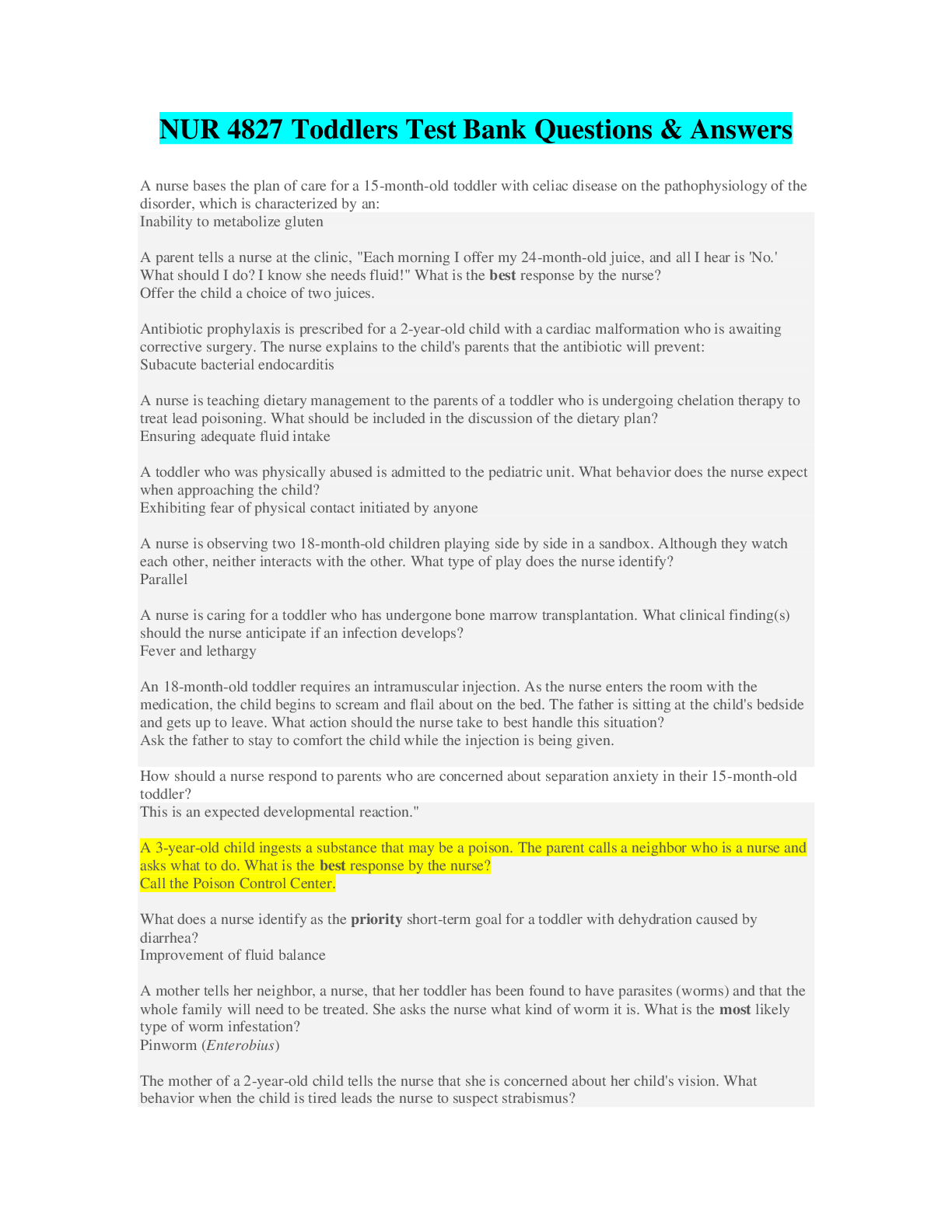
Buy this document to get the full access instantly
Instant Download Access after purchase
Add to cartInstant download
Reviews( 0 )
Document information
Connected school, study & course
About the document
Uploaded On
Apr 17, 2020
Number of pages
21
Written in
Additional information
This document has been written for:
Uploaded
Apr 17, 2020
Downloads
0
Views
158

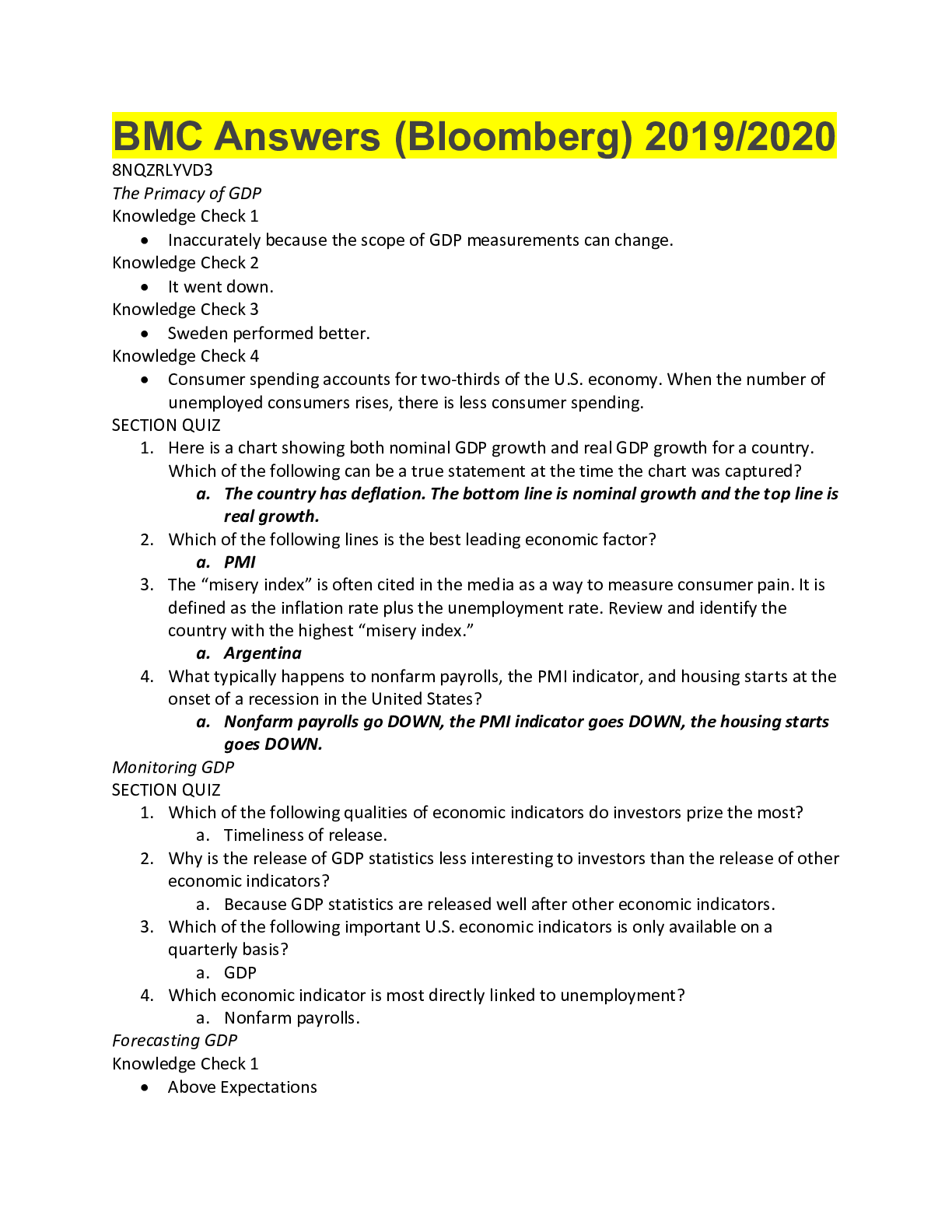
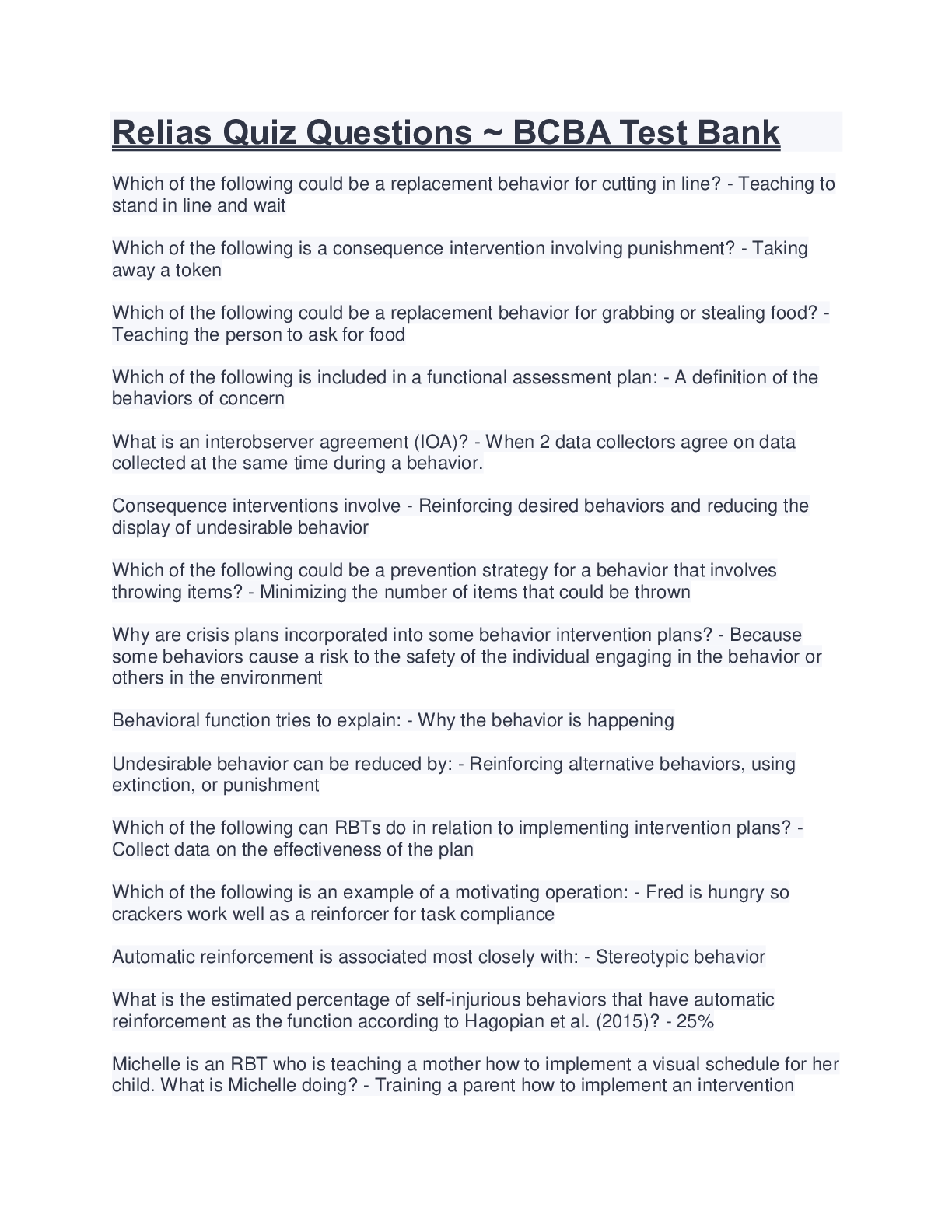
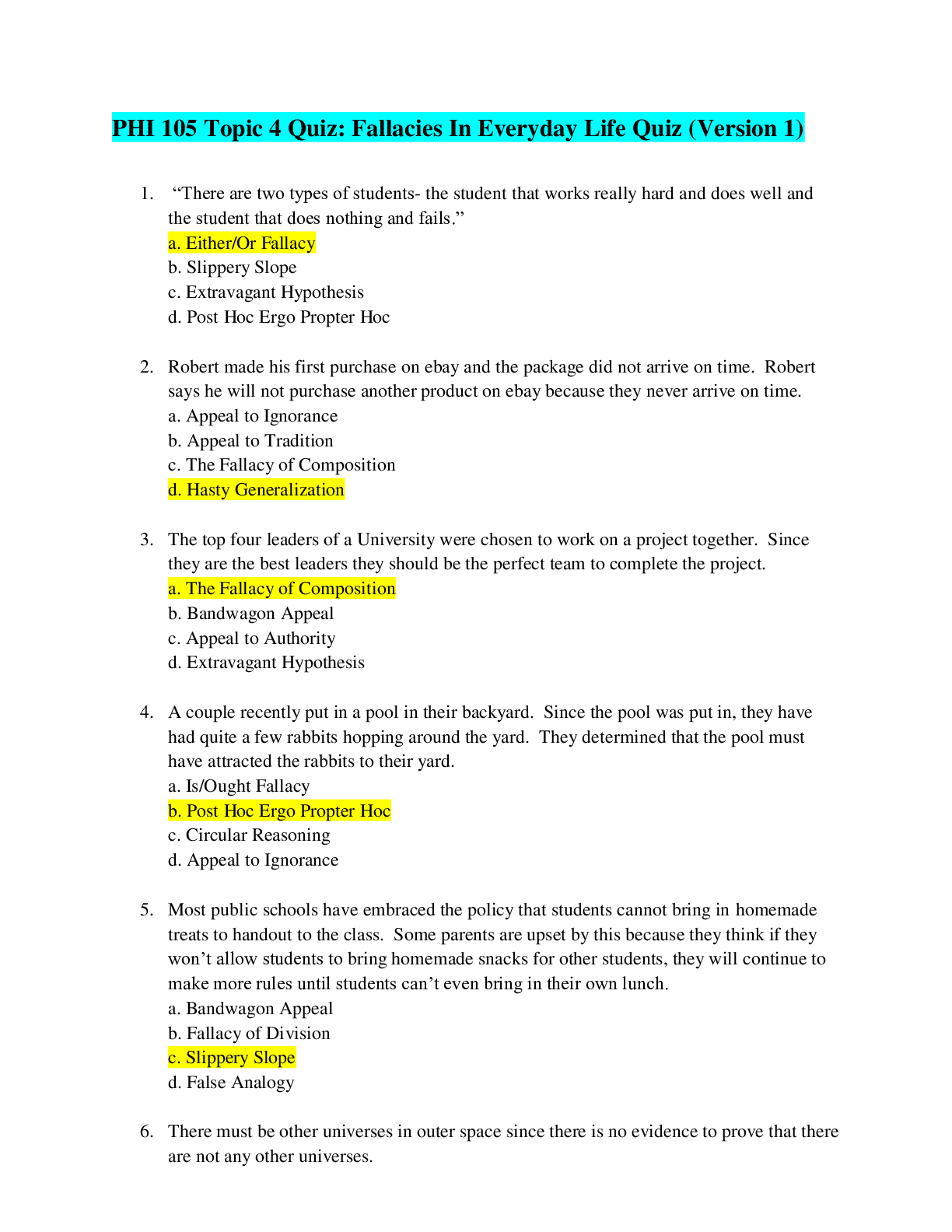


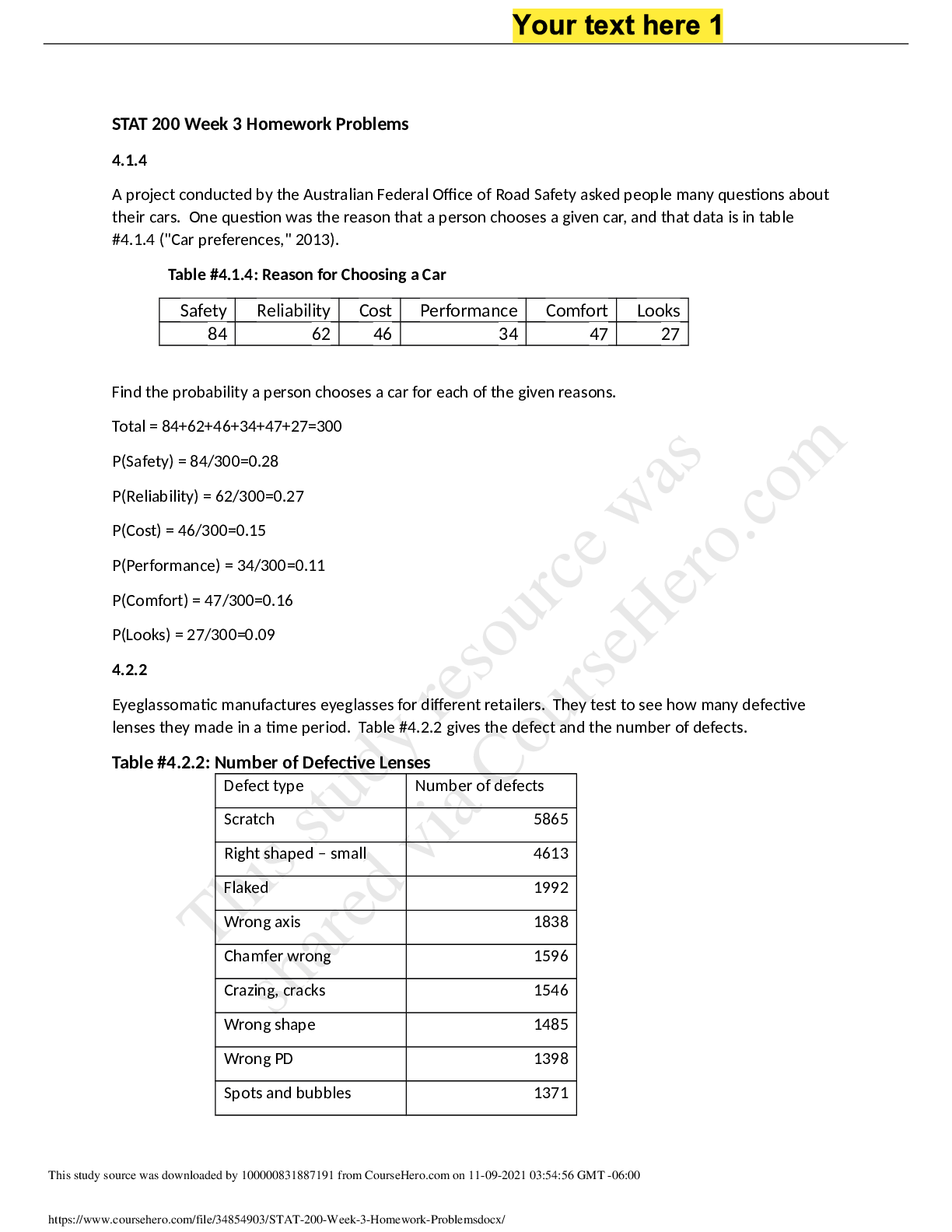

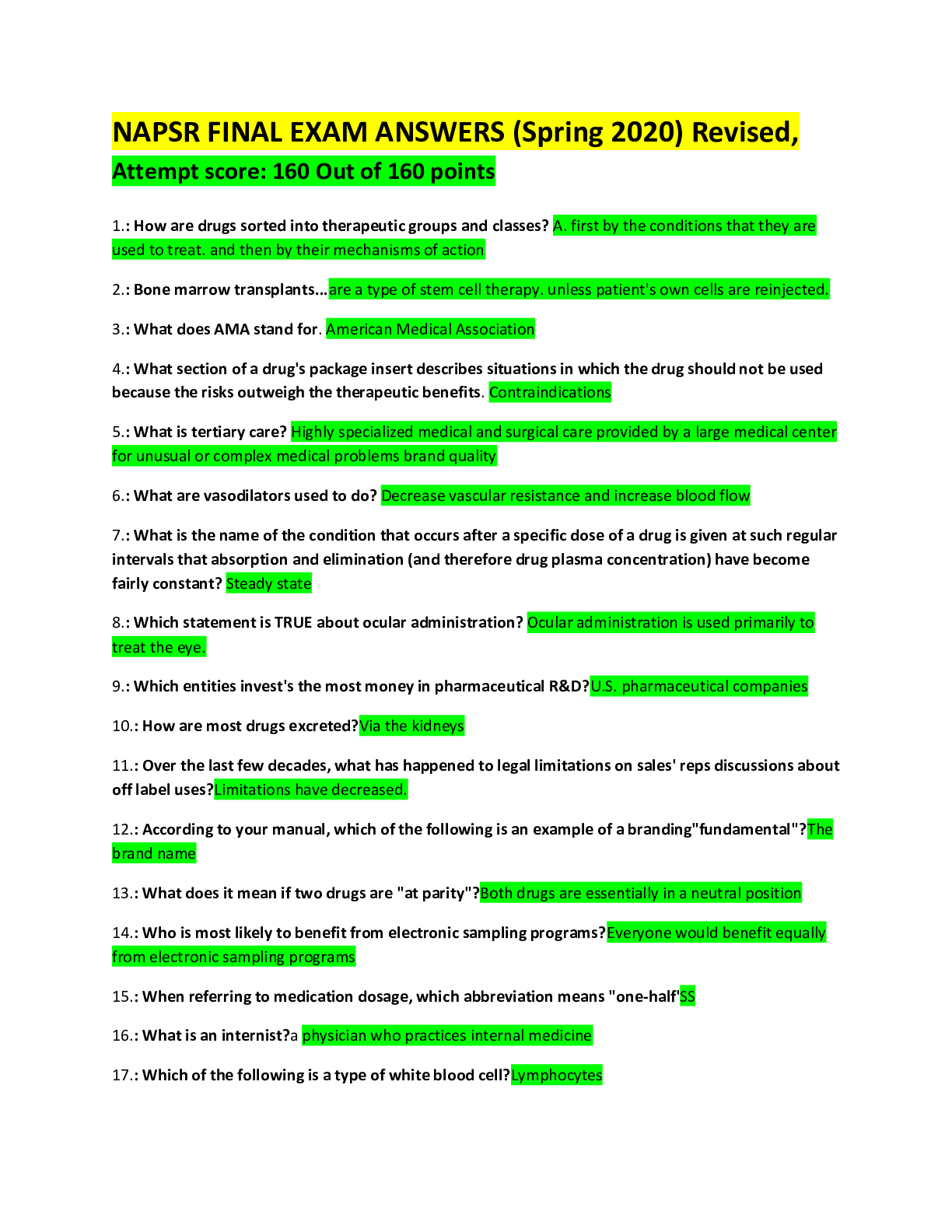

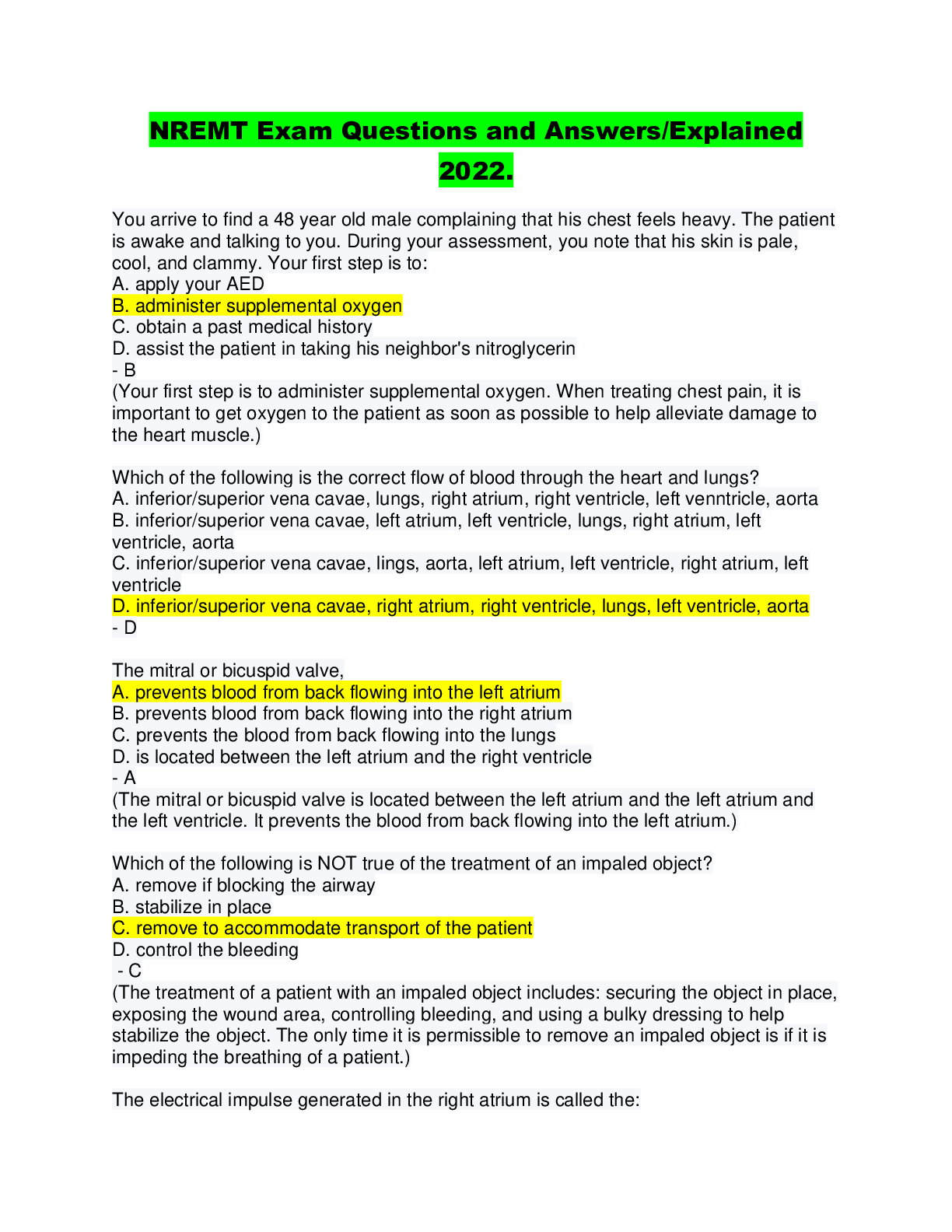
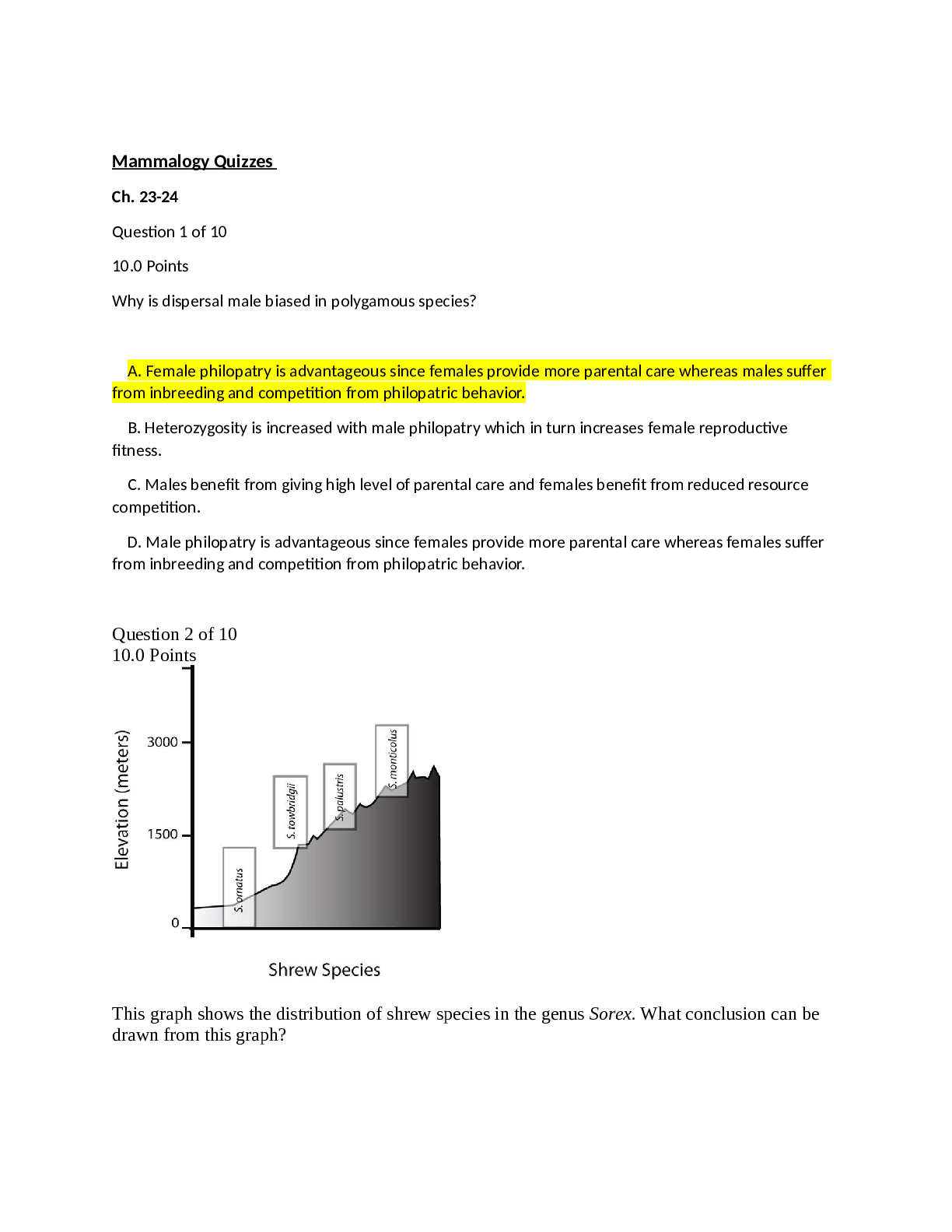
.png)
